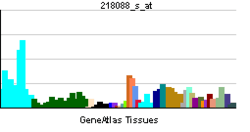RRAGC
| View/Edit Human | View/Edit Mouse |
Ras-related GTP binding C, also known as RRAGC, is a protein which in humans is encoded by the RRAGC gene.[3][4]
RRAGC is a monomeric guanine nucleotide-binding protein, or G protein. By binding GTP or GDP, small G proteins act as molecular switches in numerous cell processes and signaling pathways.[3]
Interactions
RRAGC has been shown to interact with RRAGA.[4][5]
References
- ↑ "Human PubMed Reference:".
- ↑ "Mouse PubMed Reference:".
- 1 2 "Entrez Gene: RRAGC Ras-related GTP binding C".
- 1 2 Sekiguchi T, Hirose E, Nakashima N, Ii M, Nishimoto T (Mar 2001). "Novel G proteins, Rag C and Rag D, interact with GTP-binding proteins, Rag A and Rag B". The Journal of Biological Chemistry. 276 (10): 7246–57. doi:10.1074/jbc.M004389200. PMID 11073942.
- ↑ Rual JF, Venkatesan K, Hao T, Hirozane-Kishikawa T, Dricot A, Li N, Berriz GF, Gibbons FD, Dreze M, Ayivi-Guedehoussou N, Klitgord N, Simon C, Boxem M, Milstein S, Rosenberg J, Goldberg DS, Zhang LV, Wong SL, Franklin G, Li S, Albala JS, Lim J, Fraughton C, Llamosas E, Cevik S, Bex C, Lamesch P, Sikorski RS, Vandenhaute J, Zoghbi HY, Smolyar A, Bosak S, Sequerra R, Doucette-Stamm L, Cusick ME, Hill DE, Roth FP, Vidal M (Oct 2005). "Towards a proteome-scale map of the human protein-protein interaction network". Nature. 437 (7062): 1173–8. doi:10.1038/nature04209. PMID 16189514.
Further reading
- Horwitz MS (Jan 2001). "Adenovirus immunoregulatory genes and their cellular targets". Virology. 279 (1): 1–8. doi:10.1006/viro.2000.0738. PMID 11145883.
- Rual JF, Venkatesan K, Hao T, Hirozane-Kishikawa T, Dricot A, Li N, Berriz GF, Gibbons FD, Dreze M, Ayivi-Guedehoussou N, Klitgord N, Simon C, Boxem M, Milstein S, Rosenberg J, Goldberg DS, Zhang LV, Wong SL, Franklin G, Li S, Albala JS, Lim J, Fraughton C, Llamosas E, Cevik S, Bex C, Lamesch P, Sikorski RS, Vandenhaute J, Zoghbi HY, Smolyar A, Bosak S, Sequerra R, Doucette-Stamm L, Cusick ME, Hill DE, Roth FP, Vidal M (Oct 2005). "Towards a proteome-scale map of the human protein-protein interaction network". Nature. 437 (7062): 1173–8. doi:10.1038/nature04209. PMID 16189514.
- Sekiguchi T, Todaka Y, Wang Y, Hirose E, Nakashima N, Nishimoto T (Feb 2004). "A novel human nucleolar protein, Nop132, binds to the G proteins, RRAG A/C/D". The Journal of Biological Chemistry. 279 (9): 8343–50. doi:10.1074/jbc.M305935200. PMID 14660641.
- Sekiguchi T, Hirose E, Nakashima N, Ii M, Nishimoto T (Mar 2001). "Novel G proteins, Rag C and Rag D, interact with GTP-binding proteins, Rag A and Rag B". The Journal of Biological Chemistry. 276 (10): 7246–57. doi:10.1074/jbc.M004389200. PMID 11073942.
This article is issued from Wikipedia - version of the 5/20/2016. The text is available under the Creative Commons Attribution/Share Alike but additional terms may apply for the media files.
